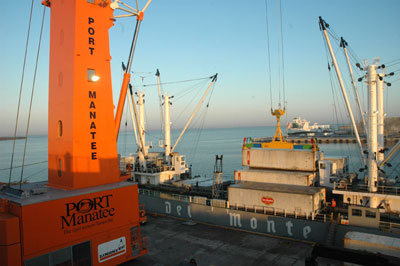 |
||||||||

Port Manatee Plays Up
Competitive Advantages
By Victoria Parsons
Positioned just inside the mouth of Tampa Bay, between the Sunshine Skyway Bridge and the Hillsborough County line, Port Manatee is Florida’s newest seaport. It’s already the state’s fourth-largest port, moving more than nine million tons of cargo per year, and it’s squarely focused on continuing that growth.
Its location on Tampa Bay puts it within two hours of 8 million residents but it’s still surrounded by more than 3700 acres of vacant land in an “encouragement zone” with incentives designed to make development as fast and easy as possible. And in Tallahassee, port officials helped pushed through a bill that exempts new construction within three miles of a port’s boundary from Development of Regional Impact (DRI) review so that surrounding lands receive the same benefits as they would if they were actually owned by the port.
The dual initiatives play up one of the port’s strongest competitive features, notes Steve Tyndal, senior director of trade development. “Port Manatee is unique among Florida ports in that we have so much property around us available for development,” he said. “Our goal is to work with private businesses to provide an opportunity for free enterprise.”
At the same time, the port is highly focused on protecting the environment, particularly nearby aquatic resources, Tyndal said.
Incentives Increase Competitiveness
Reducing or waiving impact fees for qualified businesses in the encouragement zone is one of the most important things Manatee County has ever done for economic development, notes County Commissioner Joe McClash, who chaired the port authority last year. “The encouragement zone will allow Manatee County to take advantage of opportunities surrounding the Panama Canal expansion and the time when Cuba opens for free trade.”
 Photo courtesy Port Manatee |
| A new mobile harbor container crane, purchased in partnership with Logistec Corporation, highlights Port Manatee's commitment to container shipping. |
The abundance of available, developable land and congestion-free access to Interstate 75 gives Port Manatee an advantage over many other ports in the southeast but the encouragement zone provides an extra incentive, he adds. “The reality is that Florida ports are at a disadvantage to other southeastern ports because of the incentives other states provide. We need to be more competitive and this is something we can do at the local level.”
Along with reduced impact fees for qualified development, property owners in the encouragement zone can rezone their land so it is suitable for port-related development. The county also has committed to a 90-day turnaround on building permits and is in the final stages of creating a tax-increment financing plan similar to those that have helped downtown districts across the state.
“What you do is take the tax increases that come with development and put them back into the district rather than into general revenue funds,” McClash said. “They can be re-invested in the area in many ways, from tax abatement to marketing or education.”
The county is also aggressively protecting its easy access to the interstate by working with the Florida Department of Transportation to develop plans for a connector road to be built when traffic justifies it. “The I-75 connector is a necessary component if we’re going to remain a superior intermodal facility,” Tyndal said. Engineering and environmental analysis on possible routes should be complete next year, so rights of way can be identified and construction can begin when the road is needed and funds are available.
Focused on the Future
A 10-year effort that includes one of the state’s most successful seagrass mitigation initiatives will take another major step toward completion in early 2010 when the 1,000-foot Berth 12 opens at the southwestern tip of the port. Over the next three years, anticipating the completion of the Panama Canal expansion, the port hopes to extend the berth by another 584 feet and develop a 52-acre container yard terminal that can accommodate 500,000 TEU (20-foot equivalent units) per year.
Three projects at Port Manatee are on the Sarasota/Manatee Metropolitan Planning Organization’s prioritized list of stimulus projects including the Berth 12 expansion for an estimated $22 million, the first phase of the container yard and purchasing a second container crane to handle unloading more efficiently.
Earlier this year, the port authority approved a $750 million master plan that continues the emphasis on attracting containerized shipment and related industry to the port and its encouragement zone. Environmental mitigation for a proposed new berth at the north end of the port is likely to be at the top of the priority list.
“Our mission statement calls for us to operate in an environmentally sensitive manner – they’re strong words but I believe we’ve lived up to them,” McClash said. “Water quality off Port Manatee is the best in Tampa Bay.” Manbirtee Key, an old spoil-disposal island off the port, was restored through the efforts of Port Manatee and Gulfstream Natural Gas System, LLC, and is now an important bird sanctuary.
